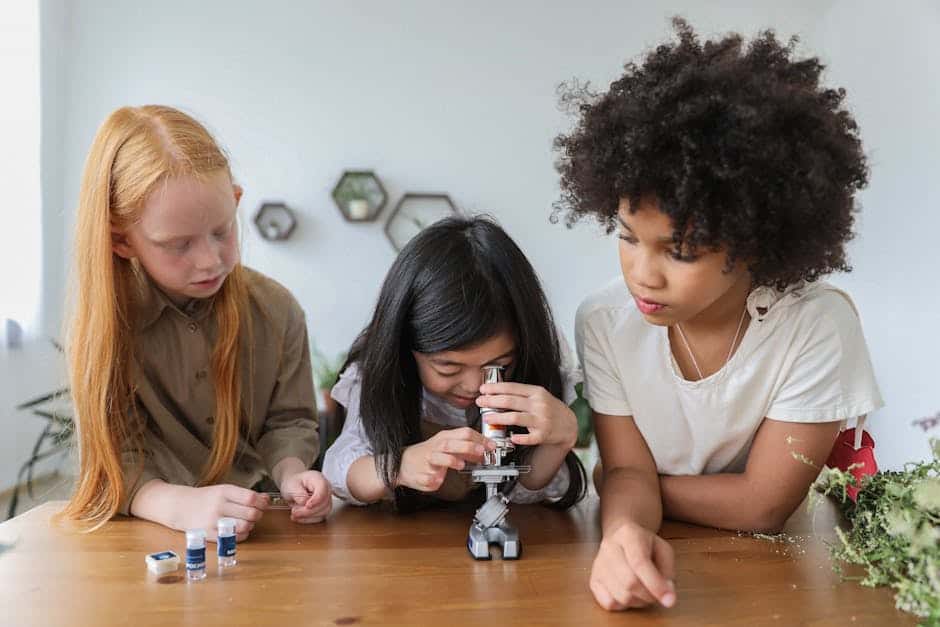Whether you’re a budding scientist, a curious student, or a parent supporting your child’s science education, setting up your first microscope station is an exciting step into the world of scientific discovery. This guide will help you create a proper microscope station that’s both functional and safe.
Why Set Up a Proper Microscope Station?
A well-organized microscope station isn’t just about having a microscope—it’s about creating a dedicated space for scientific exploration. Proper setup ensures:
- Better specimen preservation
- Clearer observations
- Safer handling of materials
- More organized research
- Protection of your equipment
Essential Equipment List
1. The Microscope
Your most important decision is choosing the right microscope. For beginners, we recommend:
Our Top Pick for Beginners: The AmScope 40X-1000X LED Student Microscope
- Perfect magnification range for beginners
- Built-in LED illumination
- Sturdy metal frame
- Includes basic prepared slides
- Excellent value for money: Check current price on Amazon
Advanced Option: Swift SW380T Trinocular Compound Microscope
- Professional-grade optics
- Better for more serious study
- Digital camera compatibility
- Superior build quality: View on Amazon
2. Basic Slide Preparation Kit
Essential Slide Kit Components: AmScope 82-Piece Slide Preparation Kit
- Glass slides
- Cover slips
- Droppers
- Basic stains
- Storage box: See pricing on Amazon
3. Microscope Cleaning Kit
Recommended Cleaning Kit: Complete Microscope Cleaning Kit
- Lens cleaning solution
- Lint-free wipes
- Air blower
- Brush
- Storage case: Check price and reviews
Setting Up Your Station
1. Choose the Right Location
Your microscope station needs:
- Stable, flat surface
- Good lighting
- Access to power outlet
- Away from water sources
- Room for note-taking
2. Essential Safety Equipment
Basic Safety Kit:
- Safety goggles
- Disposable gloves
- Lab coat or apron
- View recommended safety essentials
Maintaining Your Equipment
Proper maintenance ensures your microscope will last for years:
Daily Care
- Clean the lenses after each use
- Cover when not in use
- Store in a dry location
Monthly Maintenance
- Check all mechanical parts
- Clean the stage thoroughly
- Inspect electrical components
Recommended Accessories
Must-Have Items
- Protects from dust and debris
- Extends equipment life
- View protective covers
- Organizes prepared slides
- Protects from breakage
- Check storage options
- Additional illumination
- Adjustable positioning
- See recommended lamps
Optional but Useful
- Document observations
- Share discoveries
- View camera adapters
- Collect samples safely
- Proper storage containers
- Check collection kits
Getting Started with Your Microscope
First Observations
Start with these easy-to-find specimens:
- Onion skin
- Plant leaves
- Pond water
- Hair samples
- Salt crystals
Basic Techniques
- Clean all slides before use
- Use proper mounting techniques
- Start with lowest magnification
- Focus carefully
- Take detailed notes
Common Mistakes to Avoid
- Touching lenses with fingers
- Using dirty slides
- Improper cleaning techniques
- Storing in humid areas
- Skipping safety equipment
Investment Considerations
Starter Setup (Under $150)
- Basic microscope
- Essential slides kit
- Basic cleaning supplies
- Safety equipment
Advanced Setup ($300+)
- Higher quality microscope
- Complete slide preparation kit
- Digital documentation equipment
- Professional cleaning kit
Conclusion
A well-equipped microscope station opens up a world of scientific discovery. Start with the essentials and add components as your needs grow. Remember to prioritize safety and proper maintenance of your equipment.
Ready to start your microscopy journey? Check our recommended starter microscope here: Our Recommendation
[Have questions about setting up your microscope station? Contact us for personalized recommendations.]
Note: This post contains affiliate links. When you purchase through these links, we earn a small commission at no additional cost to you. These commissions help support our mission to provide free science education resources.

